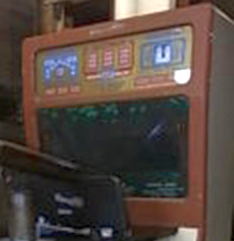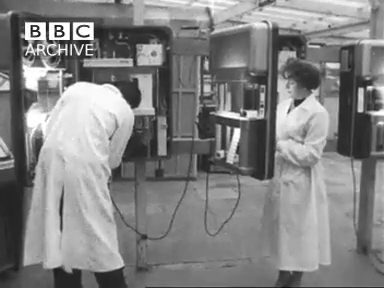Year: 1966
Company: セガ (Sega)
This poor photograph is the only image I have ever seen with Sega's Shuffleboard. Note: This might also be called "American Shuffleboard".
Sega's Shuffleboard must be electromechanical, as the articles mention lights and sounds, and that it plugs in. It notes that it is smaller than a typical shuffleboard, but regulation shuffleboards can be 12 to 20 feet in length. Typically, "arcade" shuffleboard machines are 9 feet long.
 |
| 1966-09-25 San Diego Union |
SHUFFLEBOARD
Western Game Thrills Japanese
By PHIL GLICKMAN Copley News Service
TOKYO The girl in the red ski sweater dipped her knees. clenched her fists and jauntily jerked sideways.
Her companion raised his hands in front, as if to ward off a fast throw to first base, gritted his teeth and kicked his right foot in back, looking like Charlie Chaplin disposing of a crumpled newspaper.
Across the room, similar twists, shrugs, jerks and physical manifestations were occurring accompanied by the Japanese counterpart of "Go, man, go!"
The crowd was young, not only in years but in spirit. Most were in their late teens with a few "oldsters" in their 30s plus one or two "venerable ancients" in their 40s.
The strains of a Western "love-chant" beat to a snare drum melody as the lyrics related a tale of adolescent passion. The lighting was moody.
In short, it was a "cool" evening.
Dancing? No.
Just the opening of something American. Another cultural exchange between the nations of the West and Japan. Shuffleboard has come to the Orient.
Not the traditional shuffleboard formerly found aboard the S.S. Post Depression bound for Havana, but compact, highly transistorized and ultramobile variety that can be plugged into any 110-volt house current, complete with musical victory march and pyrotechnic salute to the winner.
Sega Enterprises, one of Japan's leading manufacturers of coin-operated amusement devices, developed this latest entry in the battle to combat boredom.
Gambling that anything American would prove both financially and culturally beneficial to all, Sega's adventure into the realm of room-sized athletics has proved to be a winner on the Japanese amusement scene.
The opening-night crowd for "American Shuffleboard" was slightly less than the turnout for the opening of the Oklahoma Land Rush - but only slightly. Crowds packed themselves around the six shuffleboard facilities.
They waited in line more than two hours just to take a fling at pushing a steel hockey puck down a powdery waxed table.
By closing time, the waiting line had diminished to only 1 1/2 blocks in length.
PHOTO CAPTION: Japanese girl joins in shuffleboard craze sweeping Japan. --Copley News Service Photo
 |
| 1966-12-24 Billboard magazine |
Transcription:
Shuffleboard For Japanese Coin Market
LOS ANGELES - Sega Enterprises, one of Japan's leading manufacturers of coin-operated amusement machines, has introduced shuffleboard to the Japanese market.
Not the traditional shuffleboard found in America, according to an executive of Sega Enterprises, but rather a compact, transistorized and mobile variety that can be plugged into any 110-volt house current.
Shuffleboard-Orient style comes complete with musical Victory marches and pyrotechnic salutes to the winner.
A spokesman for Sega, traveling in the United States on a buying mission, said his company manufactured the machine in the amusement battle for the Japanese yen. "The amusement market in Japan is highly competitive," the Sega executive said, "and we gambled on shuffleboard because it pushed the company into the realm of room- sized amusement devices. A field we want to fully explore."
"We also gambled that most anything American would prove financially beneficial." American servicemen stationed in Tokyo, he said, have also stimulated interest in shuffleboard.
Sega introduced six shuffleboard machines in several Tokyo nightclubs recently and watched both Japanese and American servicemen and tourists wait in line for more than two hours to play.












































































